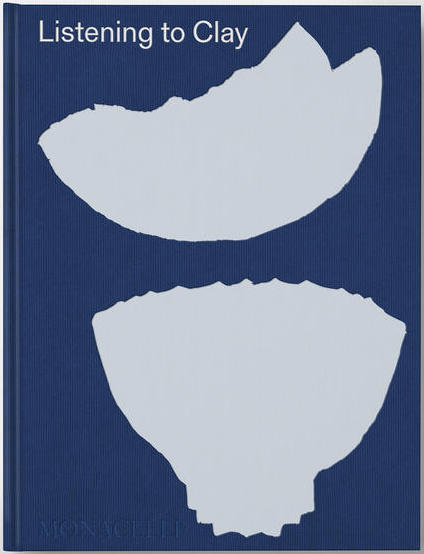
Listening to Clay: Conversations with Contemporary Japanese Ceramic Artists by Alice North, Halsey North, and Louise Allison Cort

Listening to Clay: Conversations with Contemporary Japanese Ceramic Artists by Alice North, Halsey North, and Louise Allison Cort. New York: The Monacelli Press, 352 pp., $65.00 (cloth).
In attempting to make contact with a garden’s genius loci, landscape designer Sadao Yasumoro, has said that, “While listening to the kami (gods) living at the site, and bearing in mind the feelings of the owner, I begin to work.”
There are, for those with the requisite sense, currents, energy flows, and dialogues to be discerned in the Japanese garden. Shunmyo Masuno contends that when arranging rocks, for example, one must “converse” with the stone, waiting “until it seems to speak and say where it wants to be put.” According to some of the subjects of Listening to Clay, a similar collaboration, or consulting, takes place between potters and their material. Artist Michiko Ogawa, for example, is very specific on this point, stating that she attempts to, “listen to what the material has to say,” posing the question, “What does the clay want to be?”
Listening to Clay consists of a series of interviews between long established collectors of ceramic ware, Halsey and Alice North, art historian and ceramic specialist Louise Allison Cort, and sixteen prominent Japanese proponents of the craft. Since the publication of this book, Halsey North has, sadly, passed away, the title now standing as a tribute to his passion in championing fine craft. The interviews are in-depth, reflecting the long lives and engagement of the book’s subjects to tireless experimentation. Given ample time to expand on their responses, the interviews become mini-biographies.
It’s astonishing how rapidly many of these artists managed to develop their skills and assert control over their working lives after the devastation of war. Yasuo Hayashi, a seven-decade creator of clay sculptures, recalls those early days, “kneading the clay with my bare feet on a cold winter night.” Hayashi would contend with other hurdles when his work was favorably received in Europe. He remembers the negative response from senior craftspeople from established pottery families, when the glowing reviews his work received abroad appeared in Japan. They were furious at the temerity of his success, “We were treated,” Hayashi recalls, “like outcasts.”
Kimiyo Mishima, an artist from Osaka, eschewed beauty and craft functionalism in favor of an exposé of the excessive presence of media and garbage in the world,doing so via highly original methods in which she superimposes print on clay. The results are outrageous, her critique of throwaway culture resulting in work that is antithetical to beauty, but pulsating with accusative meaning. Silkscreening and transfer-printing newspaper text on clay results, in some instances, in surfaces reminiscent of early Braque montages. Hauling suitcases of old newspapers and cardboard boxes from New York, the artist muses on her work with such materials, “I think of it as a documentation of my life.” I recently came across her Another Rebirth 2005-N, a four-meter plus tall, rubbish filled waste basket, made from glazed stoneware, iron, fragmented tile and slag, standing in a patch of weeds on the island of Naoshima. In common with countless public works projects in Japan that are initiated with great enthusiasm, then subjected to neglect and poor maintenance, Mishima’s waste bin is gradually turning, with the help of rust, dirt and rain, into the garbage it imitates.
A childhood habitué of the Kyoto ceramic district of Gojozaka, Morino Hiroaki Taimei is a preeminent figure in his field, one whose sculptural forms are executed in stoneware clay using his own original glazes. His work, geometric, angular, oppositional to the curve, defines him as a devoted modernist, with his roots firmly grounded in his hometown. “The result of my going to America,” he asserts, “was not to become like an American but to reconsider my identity as a person born and brought up in Kyoto.”
Implacably modern, but hailing from the ancient ceramic center of Shigaraki, Kohyama Yasuhisa grew up in a post-war Japan where food was scarce, family and community plentiful. Though he claims never to have gone to high school, his work can hardly be described as unschooled. We learn that the technique used to create his rough-surfaced, highly tactile sculptural ceramics involves slicing the coarse clay with a wire, before exposing work to several firings, a method that reveals the surface of the material.
Koike Shoko, an internationally exhibited artist, creates vessels, containers and sculptured forms by tucking and kneading clay in a manner similar to the way you would treat pleats in a skirt or curtain. Perhaps this should be of little surprise, as she is the daughter of a clothing design professor. Many of her designs are based on the shape of shells, though she is quick to assert, “There are no natural shells that look like my work.” What we see are supra-real forms. In other words, art. Experimental ceramicist, Machiko Ogawa, expresses her affinity with rocks and minerals by creating sculptural works, replete with cracks and fragmentation, that appear to have been prized or wrenched from the earth, friable cliff sides or quarries.
The book illustrates how works accrue distinction, market value, and prestige as they are processed through the exhibition system. When it comes to selling their work, many artists prefer the professionals to take over. It’s fitting that the book should include in its closing pages, an interview with the Kyoto based dealer and ceramics writer, Robert Yellin. A longtime columnist for The Japan Times, Yellin introduced an entire readership to the world of Japanese ceramics. Relocating to Kyoto in 2011, he now runs a gallery situated along the iconic Philosopher’s Path. Shifting from predominantly online sales to a person-to-person model, the gallery allows him to meet customers, to humanize the transactional aspect of ceramic sales.
Space precludes mention of all the artists appearing in this book. Readers will have the pleasure of discovering these for themselves. To say they don’t make books like this anymore is not quite accurate, but titles such as this one, on which so much care and attention has been placed on judicious editing, layout and visual presentation, does put this title in an increasingly rarified category of craft publishing.
Like the works it represents, the book is in a class of its own.

Stephen Mansfield, originally from the UK, is a prolific writer on Japanese culture and has published several key books on aspects of Japanese gardens.